VTech Telecommunications 80-8015-03 1.9GHz Digital Modulation Cordless Phone User Manual CS6114 X NO LED ACIB 20121024 for approval
VTech Telecommunications Ltd 1.9GHz Digital Modulation Cordless Phone CS6114 X NO LED ACIB 20121024 for approval
User Manual
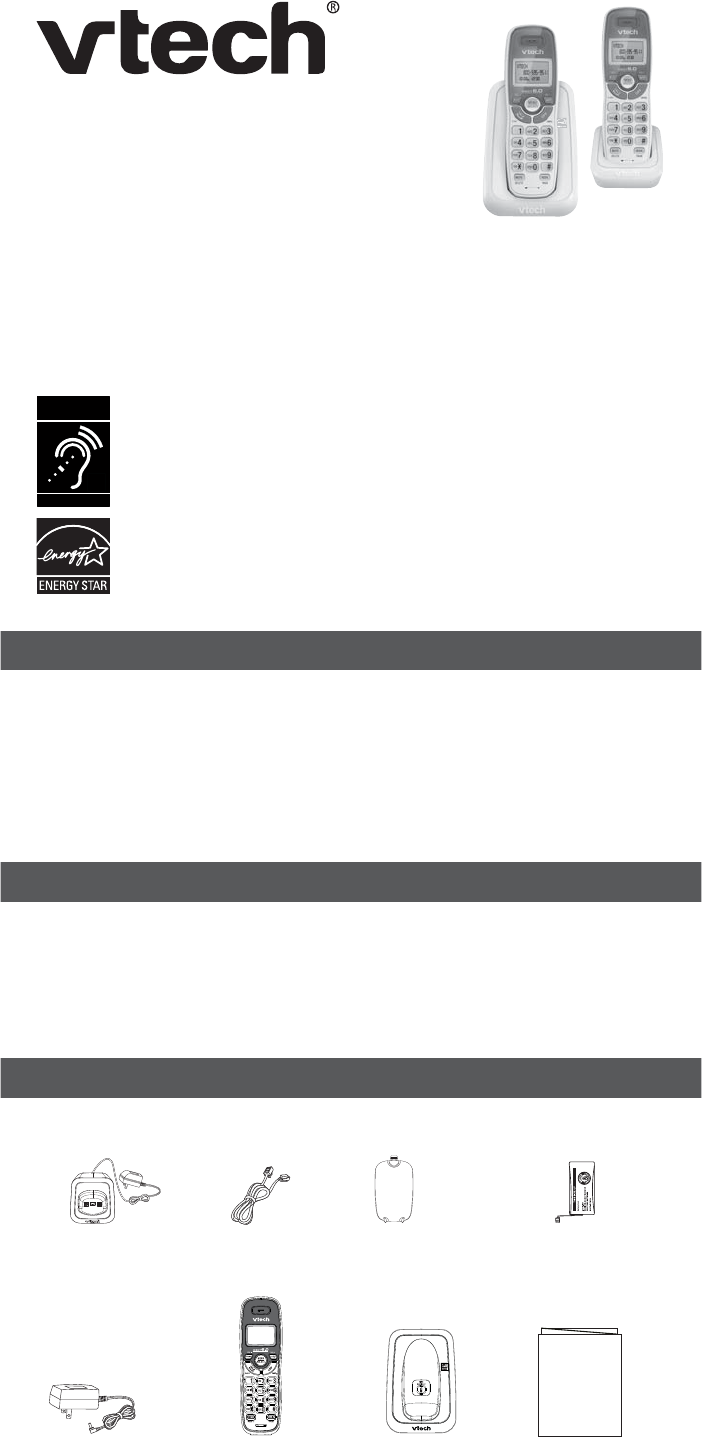
1
CS6114/CS6114 B/CS6114-11/
CS6114-11 B/CS6114-2/
CS6114-2 B/CS6114-21/CS6114-21 B
DECT 6.0 cordless telephone
Register online to get an additional 3-month warranty!
Go to www.vtechphones.com to register your product for enhanced warranty
support and latest VTech product news.
Abridged user’s manual
To protect our environment and conserve natural resources, this Abridged
user’s manual provides you with the basic installation and use instructions. A
limited set of features are described in abbreviated form.
Please refer to the online Complete user’s manual for a full set of installation
and operation instructions at www.vtechphones.com.
Before using this VTech product, please read Important safety instructions
on page 10 of this user’s manual.
This telephone does not have a built-in answering system. Voicemail is a
feature available from most telephone service providers. It may be included with
your telephone service, or may be optional. Fees may apply. This telephone
alerts you when you have new voicemail messages; see page 5 for details.
Contact your telephone service provider for instructions on how to set up your
voicemail feature and listen to messages.
Your telephone package contains the following items. Save your sales receipt
and original packaging in the event warranty service is necessary.
Abridged user’s manualTelephone base
Telephone base
power adapter
Telephone
line cord
CANCEL
Battery
(1 for CS6114/CS6114 B/
CS6114-11/CS6114-11 B)
(2 for CS6114-2/CS6114-2 B/
CS6114-21/CS6114-21 B)
Battery compartment
cover
(1 for CS6114/CS6114 B/
CS6114-11/CS6114-11 B)
(2 for CS6114-2/CS6114-2 B/
CS6114-21/CS6114-21 B)
Charger and charger
adapter
(1 for CS6114-2/CS6114-2 B
CS6114-21/CS6114-21 B )
Handset
(1 for CS6114/CS6114 B/
CS6114-11/CS6114-11 B)
(2 for CS6114-2/CS6114-2 B/
CS6114-21/CS6114-21 B)
Abridged user’s manual
Introduction
Voicemail
Parts checklist
The ENERGY STAR® program (www.energystar.gov) recognizes
and encourages the use of products that save energy and help
protect our environment. We are proud to mark this product with
the ENERGY STAR® label indicating it meets the latest energy
efficiency guidelines.
Telephones identified with this logo have reduced noise and
interference when used with most T-coil equipped hearing aids and
cochlear implants. The TIA-1083 Compliant Logo is a trademark of
the Telecommunications Industry Association. Used under license.
T
Compatible with
Hearing Aid T-Coil
TIA-1083
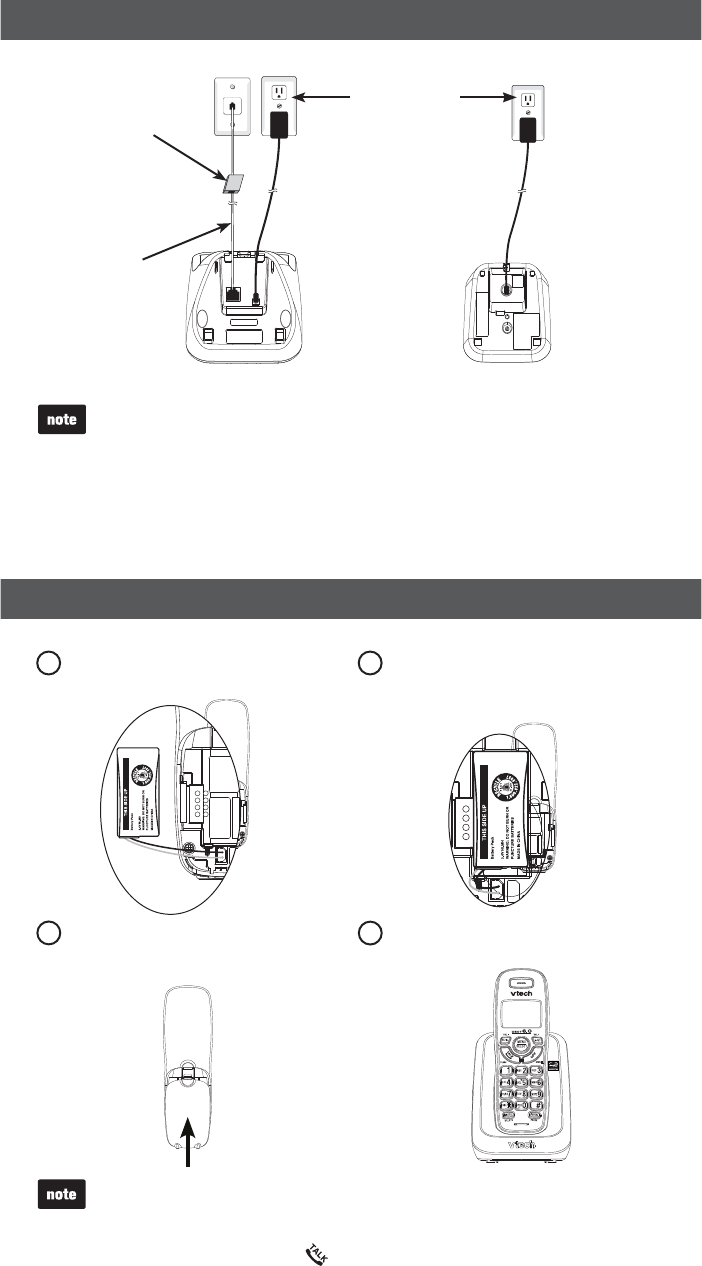
2
Install the telephone base and charger as shown below.
Telephone base
Telephone
line cord
Electrical outlet
(not controlled
by a wall switch)
A DSL filter (not
included) is
required if you have
DSL high-speed
Internet service
Charger
Telephone base and charger installation
Use only the power adapters and batteries supplied with this product. To
order a replacement, visit our website at www.vtechphones.com or
call 1 (800) 595-9511. In Canada, go to www.vtechcanada.com or call
1 (800) 267-7377.
The power adapters are intended to be correctly oriented in a vertical or floor
mount position. The prongs are not designed to hold the plug in place if it is
plugged into a ceiling, under-the-table or cabinet outlet.
If you subscribe to telephone service from a cable company or a VoIP service
provider, contact your cable/VoIP service provider for more information.
•
•
•
Install the battery as shown below.
If the handset will not be used for a long period of time, disconnect and
remove the battery to prevent any possible leakage.
2
CANCEL
3Slide the battery compartment
cover towards the center of the
handset until it clicks into place.
Place the handset in the telephone
base or charger to charge.
4
1Plug the battery connector
securely into the socket.
Place the battery with the label
THIS SIDE UP facing up and
the wires inside the battery
compartment.
IMPORTANT:
Check for a dial tone by pressing . If you hear a dial tone, the installation
is successful.
If you do not hear a dial tone:
Make sure the installation procedures described above are properly done.
If you subscribe to telephone service from a cable company or a VoIP service
provider, contact your cable/VoIP service provider for more information.
•
•
Battery installation
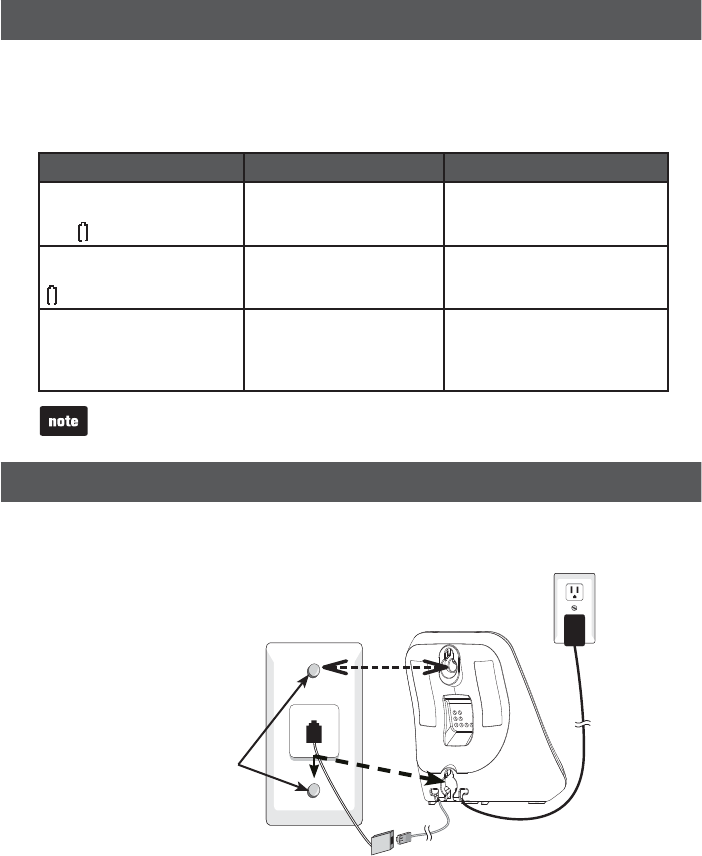
3
Your telephone comes ready for tabletop use.
To mount your telephone on the wall:
Position the top hole at the back of the telephone base against the top
mounting stud [A].
Slide the telephone base down on the mounting
studs [A] and [B] until it locks into place.
1.
2.
Telephone base
[A]
[B]
Mounting
studs
Wall mounting (optional)
Once you have installed the battery, the screen indicates the battery status
(see the table below). For best performance, keep the handset in the
telephone base or charger when not in use. The battery is fully charged after
16 hours of continuous charging. Refer to the online Complete user’s manual
for battery operating times.
Battery indicators Battery status Action
The screen is blank, or
displays Place in charger
and flashes.
The battery has very
little or no charge. The
handset cannot be used.
Charge without interruption
(at least 30 minutes).
The screen displays
Low battery and
flashes.
The battery has enough
charge to be used for a
short time.
Charge
without interruption
(about 30 minutes).
The screen displays
HANDSET X.
The battery is charged. To keep the battery charged,
place it in the telephone
base or charger when not
in use.
If you place the handset in the telephone base or charger without plugging in
the battery, the screen displays No battery.
Battery charging
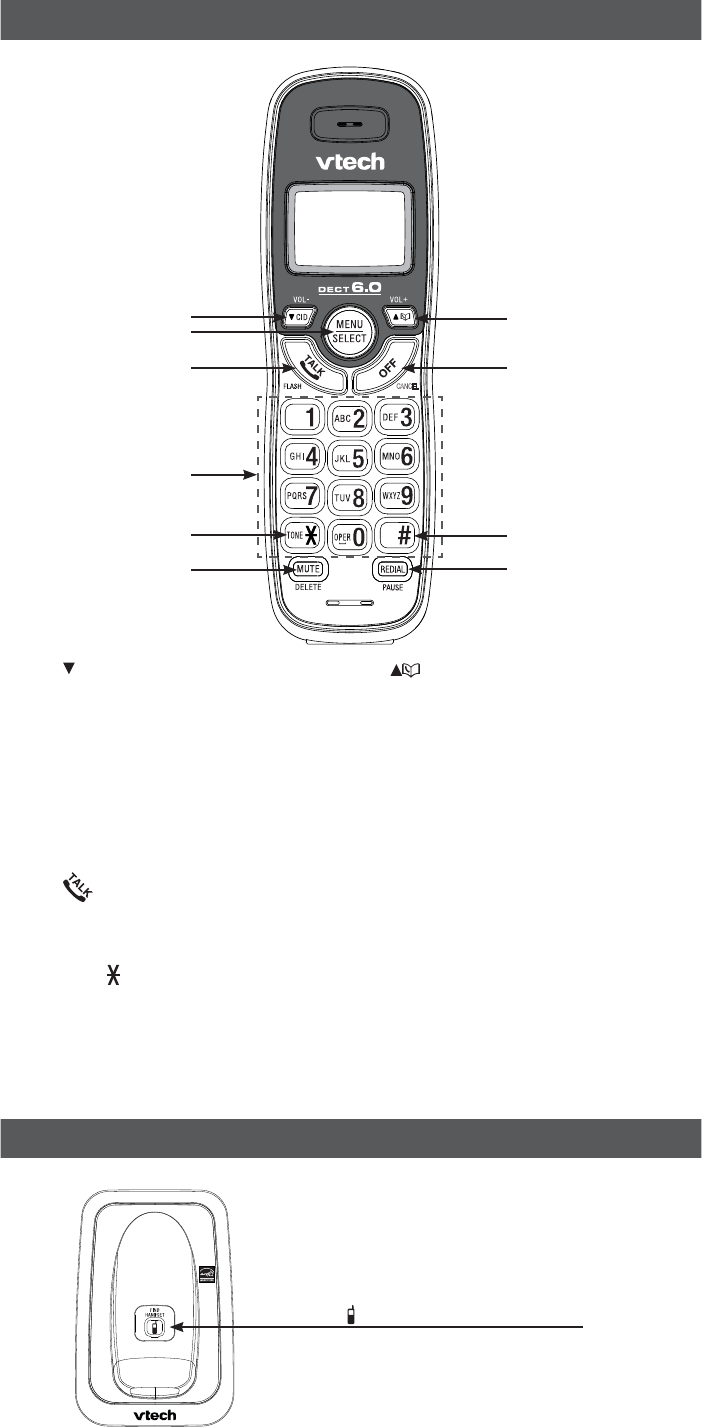
4
/FIND HANDSET
Page all system handsets.
1 – CID/VOL-
Review the caller ID log when the
telephone is not in use.
Decrease the listening volume
during a call.
Scroll down while in a menu.
2 – MENU/SELECT
Show the menu.
Select an item or save a setting
while in a menu.
3 – /FLASH
Make or answer a call.
4 – Dialing keys (0-9, TONE* & #)
5 – TONE
Switch to tone dialing temporarily.
6 – MUTE/DELETE
Mute the microphone.
Delete digits or characters.
•
•
•
•
•
•
•
•
•
7 – /VOL+
Review the directory when the
telephone is not in use.
Increase the listening volume during
a call.
Scroll up while in a menu.
8 – OFF/CANCEL
Hang up a call.
Return to the previous menu while
in a menu.
9 – #
Show other dialing options when
reviewing a caller ID log entry.
10 – REDIAL/PAUSE
Review the redial list.
Insert a dialing pause.
•
•
•
•
•
•
•
•
CANCEL
Handset overview
1
2
3
4
5
610
9
8
7
Telephone base overview
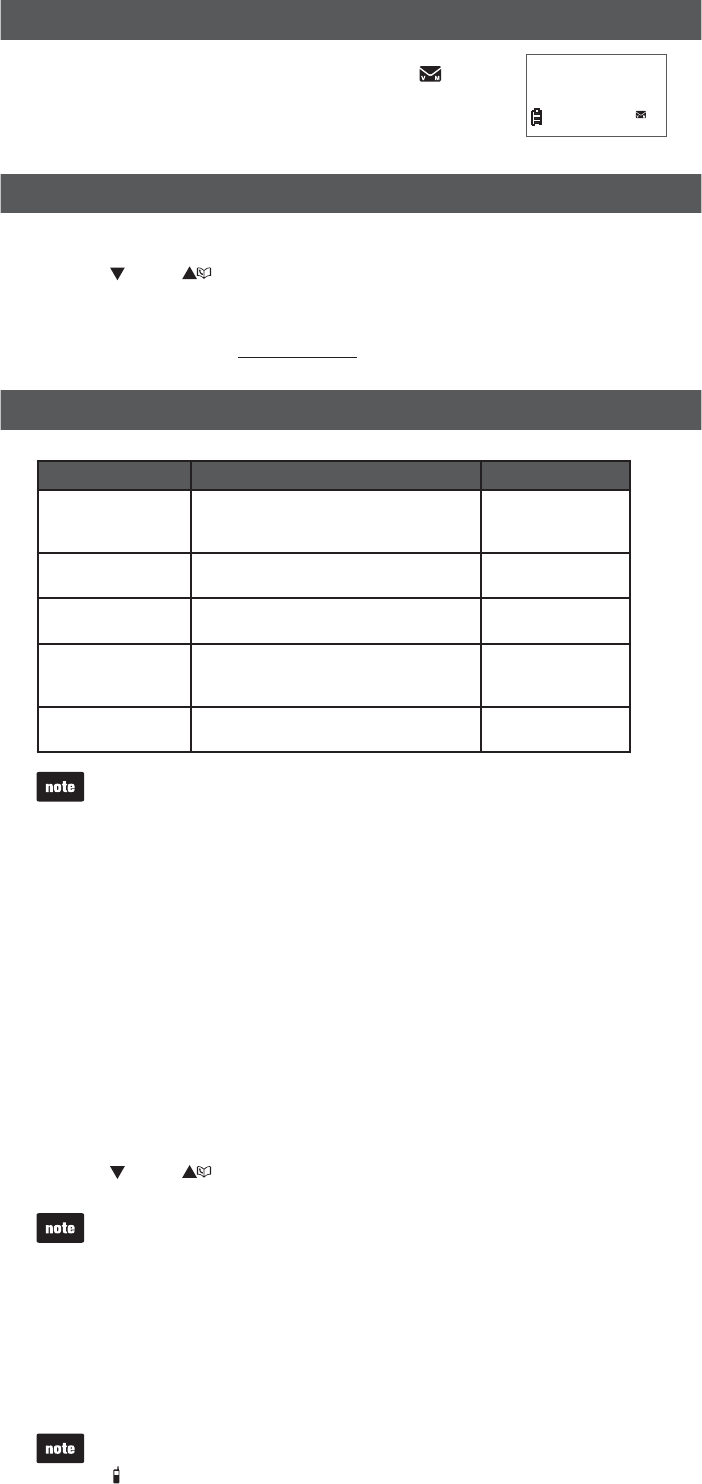
5
Default settings are indicated by asterisks (*).
Settings menu Description Options
LCD language Set the screen display language. English*;
Français;
Español
Clr voicemail Turn off the voicemail indicators (see
the note below).
Reset VM Icon?
Key tone Set whether the handset beeps
whenever a key is pressed.
On*;
Off
Home area code Set the home area code so that the
caller ID log stores only seven digits
for local telephone numbers.
Home area code
_ _ _
Dial mode Set the telephone to be touch-tone or
pulse dialing.
Touch-tone*;
Pulse
The following are some of the telephone features you may wish to set. Refer to
Telephone settings in the online Complete user’s manual for detailed instructions
on setting all telephone features.
Set date and time
If you subscribe to caller ID service, the day, month and time are set
automatically with each incoming call.
To set the date and time manually:
Press MENU when the handset is not in use.
Scroll to select Set date/time then press SELECT.
Use the dialing keys (0-9) to enter the month, date and year. Press SELECT
to advance to set the time.
Use the dialing keys (0-9) to enter the hour and minute. Press SELECT.
Press CID or to choose AM or PM. Press SELECT to save
your settings.
Ringer volume
You can adjust the ringer volume level, or turn the ringer off.
Press MENU when the handset is not in use.
Scroll to Ringers and then press SELECT twice to choose
Ringers volume.
Press VOL- or VOL+ to sample each volume level.
Press SELECT to save your selection.
1.
2.
3.
4.
5.
1.
2.
3.
4.
If the ringer volume is set to Off, the idle screen displays Ringer off.
When the ringer volume is set to Off, the handset still rings when you press
/FIND HANDSET.
•
•
When there is a power failure or after battery replacement, the date and
time needs to be reset.
To enter the handset menu:
Press MENU when the telephone is not in use.
Press CID or until the screen displays the desired feature menu.
Press SELECT to enter that menu.
To return to the previous menu, press OFF/CANCEL.
To return to idle mode, press and hold OFF/CANCEL.
1.
2.
3.
•
•
If you subscribe to voicemail service offered by your
telephone service provider, New voicemail and appear
on the handset when you have new voicemail messages.
Contact your telephone service provider for more information
and assistance about using your voicemail service.
New voicemail
10:15 PM
12/25
Use the Clr voicemail feature when the telephone indicates there is new
voicemail but there is none. For example, when you have accessed your
voicemail while away from home. The Clr voicemail feature only turns off the
indicators; it does not delete your voicemail messages. As long as you have
new voicemail messages, your telephone service provider continues to send
the signal that turns on the indicators.
Voicemail indicator
Using the menu
Telephone settings
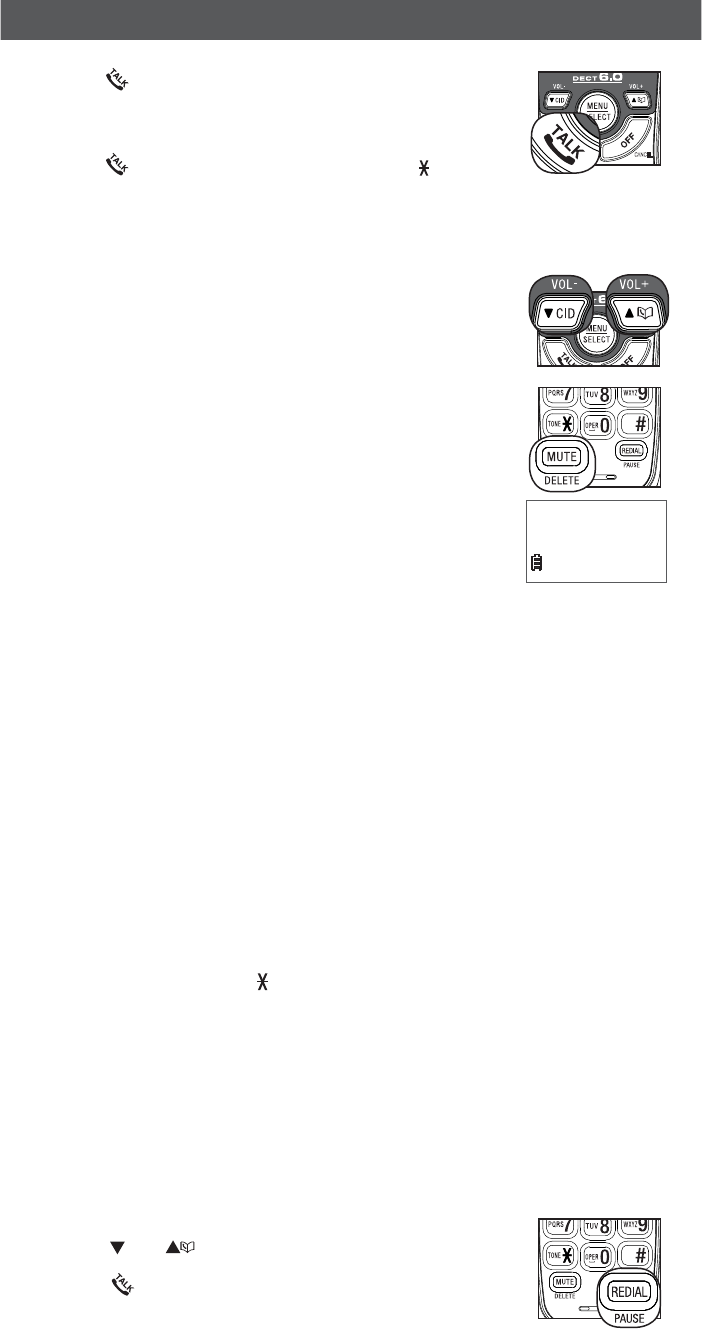
6
Make a call
Press and then dial the telephone number.
Answer a call
Press or any of the dialing keys (0-9, TONE or #).
End a call
Press OFF or put the handset to the telephone base or charger.
Volume
During a call, press VOL- or VOL+ to adjust the
listening volume.
Mute
The mute function allows you to hear the other party but the
other party cannot hear you.
During a call, press MUTE. The screen displays Muted
until the mute function is turned off.
Press MUTE again to resume the conversation. The
screen temporarily displays Microphone on.
Call waiting
When you subscribe to call waiting service from your telephone service
provider, you hear an alert tone if there is an incoming call while you are on
another call.
Press FLASH to put the current call on hold and take the new call.
Press FLASH at any time to switch back and forth between calls.
Temporary ringer silencing
When the telephone is ringing, you can temporarily silence the ringer of the
handset without disconnecting the call. The next call rings normally at the
preset volume.
To silence the handset ringer, press OFF or MUTE and then
Ringer muted displays.
Temporary tone dialing
If you have pulse (rotary) service only, you can switch from pulse to tone
dialing temporarily during a call. This is useful if you need to send touch-tone
signals to access your telephone banking or long distance services.
During a call, press TONE .
Use the dialing keys to enter the relevant number. The telephone sends
touch-tone signals.
The telephone automatically returns to pulse dialing mode after you end
the call.
Redial
Each handset stores the five most recently dialed numbers. When there are
already five entries, the oldest entry is deleted to make room for the new entry.
To review and dial a number from the redial list:
Press REDIAL when the handset is not in use.
Press CID, or REDIAL repeatedly until the desired
entry displays.
Press to dial.
To delete a redial entry:
When the desired redial entry displays, press DELETE.
•
•
•
•
1.
2.
•
•
•
1.
2.
3.
1.
2.
3.
Ringer muted
10:15 PM
12/25
Telephone operation
CANCEL
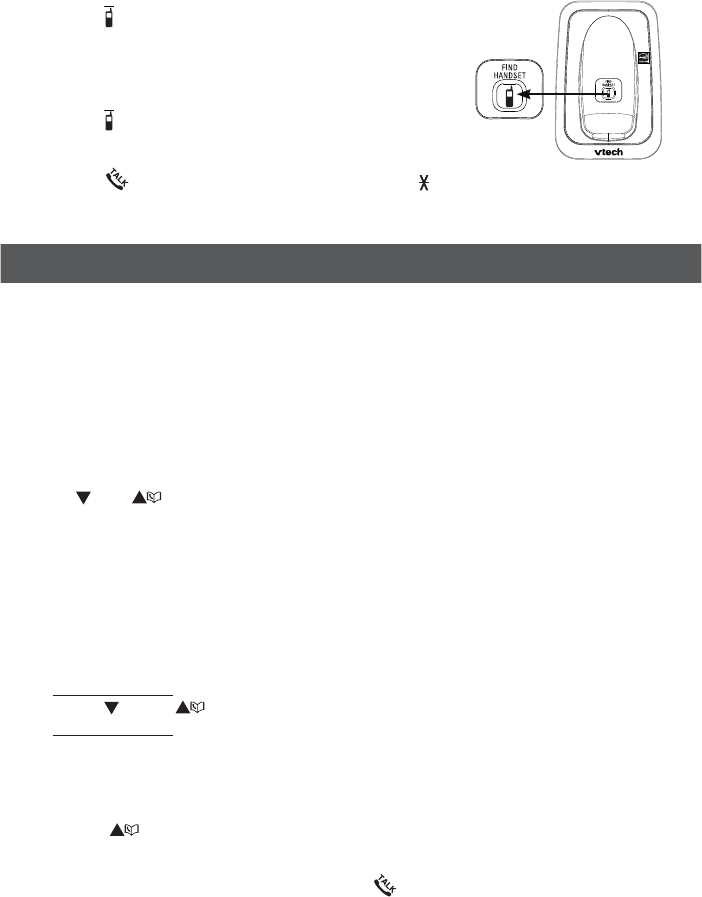
7
The directory can store up to 30 entries.
Each handset directory is independent (for CS6114-2 only). Any additions,
deletions or edits made on one handset are not reflected on the other handset.
To add a directory entry:
Press MENU/SELECT three times when the handset is not in use.
2. When the screen displays Enter number:
Use the dialing keys to enter the number (up to 30 digits).
-OR-
Copy a number from the redial list by pressing REDIAL and then press
CID, or REDIAL repeatedly to select a number. Press SELECT to
copy the number.
Press SELECT to move to the name.
When the screen displays Enter name, use the dialing keys to enter the
name (up to 15 characters). Additional key presses show other characters of
that particular key.
Press SELECT to store the entry.
While entering names and numbers, you can:
Press DELETE to backspace and erase a digit or character.
Press and hold DELETE to erase the entire entry.
Press CID or to move the cursor to the left or right.
Press and hold PAUSE to insert a dialing pause.
Press 0 to add a space.
To review and dial a number from the directory:
Entries are sorted alphabetically.
Press when the handset is not in use.
Scroll to browse through the directory, or use the dialing keys to start a
name search.
When the desired entry appears, press to dial.
To edit a directory entry:
When the desired entry displays, press SELECT.
When the screen displays Enter number, use the dialing keys to edit.
Press SELECT.
When the screen displays Edit name, use the dialing keys to edit.
Press SELECT to confirm.
To delete a directory entry:
When the desired entry displays, press DELETE.
When the screen displays Delete contact?, press SELECT.
1.
•
•
3.
4.
5.
•
•
•
•
•
1.
2.
3.
1.
2.
3.
4.
5.
1.
2.
Find handset
Use this feature to find all system handsets.
To start paging:
Press /FIND HANDSET on the telephone base
once and then release when the telephone is not
in use. All system handsets ring and flash
** Paging **.
To end paging:
Press /FIND HANDSET on the telephone base
once and then release.
-OR-
Press or any of the dialing keys (0-9, TONE or #) on the handset to stop
the paging tone.
•
•
•
Directory
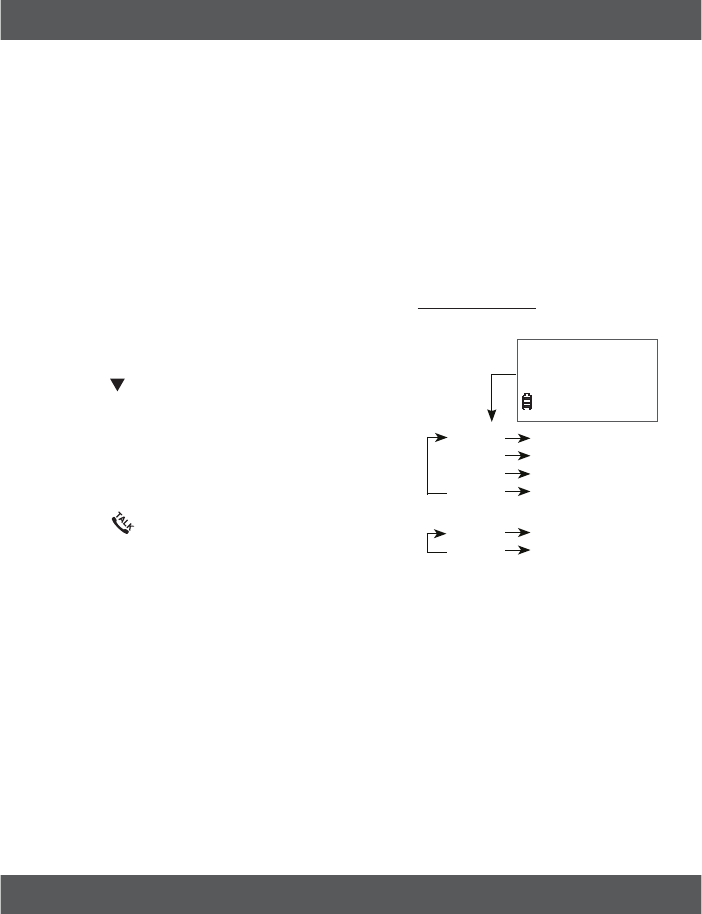
8
This product supports caller ID services provided by most telephone service
providers. Depending on your service subscription, you may see the caller’s
name, number, date and time of calls that are sent by your telephone service
provider after the first or second ring.
Caller ID log
The caller ID log stores up to 30 entries. If you answer a call before the caller
information appears, it will not be saved in the caller ID log.
Caller ID log entries are shared by all system handsets (for CS6114-2 only).
Any deletions made on one handset are reflected on the other handset.
The handset displays XX missed calls when there are calls that that have
not been answered.
If you want to erase the missed call indicator, press and hold CANCEL on
the idle handset.
To review and dial a number in the caller ID log:
Press CID when the handset is not in use.
Scroll to browse through the caller ID log. When the
desired entry appears:
Press # repeatedly to show different
dialing options.
Press 1 repeatedly if you need to add or
remove 1 in front of the telephone number.
Press to dial.
To save a caller ID log entry to the directory:
When the desired caller ID log entry displays, press SELECT.
When the screen displays Edit number, use the dialing keys to modify the
number if necessary.
Press SELECT.
When the screen displays Edit name, use the dialing keys to modify the
name if necessary.
Press SELECT to confirm.
To delete the caller ID log entries:
Delete an entry: When the desired caller ID log entry displays, press
DELETE.
Delete all entries: Press MENU when the handset is not in use. Scroll to
•
•
•
1.
2.
•
•
3.
1.
2.
3.
4.
5.
•
•
Press # 1-800-595-9511
Press # 595-9511
Press # 1-595-9511
Press # 800-595-9511
-OR-
Press 1 1-800-595-9511
Press 1 800-595-9511
Mike Smith
800-595-9511
10:15 PM
12/25
Caller ID
Troubleshooting
If you have difficulty with your telephone, please try the suggestions below.
For customer service, visit our website at www.vtechphones.com or call
1 (800) 595-9511. In Canada, go to www.vtechcanada.com or call
1 (800) 267-7377.
My telephone does not work at all.
Make sure the battery is installed and charged correctly. For optimum daily performance,
return the handset to the telephone base or charger after use.
Make sure the power adapter is securely plugged into an outlet not controlled by a
wall switch.
Make sure the telephone line cord is plugged firmly into the telephone base and the
wall jack.
Unplug the electrical power to the telephone base. Wait for approximately 15 seconds,
then plug it back in. Allow up to one minute for the cordless handset and telephone base
to synchronize.
Charge the battery in the handset for up to 16 hours.
If the battery is completely depleted, it may take up to 30 minutes to charge the handset
before Low battery appears on the screen.
Remove and install the battery again. If that still does not work, it may be necessary to
purchase a new battery.
Disconnect the telephone base from the telephone wall jack and plug in a working
telephone. If the other telephone does not work, the problem is probably in the wiring or
the local telephone service. Contact your telephone service provider.
There is no dial tone.
Try all the above suggestions.
Move the handset closer to the telephone base. It may be out of range.
The telephone line cord may be defective. Install a new telephone line cord.
Disconnect the telephone base from the telephone wall jack and connect a different
telephone. If there is no dial tone on this telephone either, the problem is in your wiring
or local telephone service. Contact your telephone service provider.
If you have changed your telephone service to digital service from a cable company or
a VoIP service provider, the telephone line may need to be rewired to allow all existing
telephone jacks to work. Contact your service provider for more information.
•
•
•
•
•
•
•
•
•
•
•
•
•
9
I cannot dial out.
Try all the above suggestions.
Make sure there is a dial tone before dialing. It is normal if the handset takes a second or
two to synchronize with the telephone base before producing a dial tone. Wait an extra
second before dialing.
If other telephones in your home are having the same problem, the problem is in the
wiring or local telephone service. Contact your telephone service provider (charges
may apply).
Eliminate any background noise. Mute the cordless handset before dialing, or dial from
another room in your home with less background noise.
Low battery shows on the handset screen.
Place the handset in the telephone base or charger for recharging.
Remove and install the battery again and use it until fully depleted, then charge the
handset in the telephone base or charger for up to 16 hours.
If the above measures do not correct the problem, replace the battery.
The telephone does not ring when there is an incoming call.
Make sure the handset ringer volume is not set to off.
Make sure the telephone line cord and power adapter are plugged in properly.
The handset may be too far from the telephone base. Move it closer to the
telephone base.
There may be too many extension phones on the telephone line to allow all of them to
ring simultaneously. Unplug some of them.
If other telephones in your home are having the same problem, the problem is in the
wiring or local telephone service. Contact your telephone service provider (charges
may apply).
Other electronic products such as HAM radios and other DECT phones can cause
interference with your cordless phone. Try installing your phone as far away as possible
from these types of electronic devices.
Test a working telephone at the telephone wall jack. If another telephone has the same
problem, the problem is in the telephone wall jack. Contact your telephone service
provider (charges may apply).
The telephone line cord may be defective. Install a new telephone line cord.
Remove and install the battery again and place the handset in the telephone base.
Wait for the handset to synchronize with the telephone base. Allow up to one minute for
this to take place.
My handset beeps and is not performing normally.
Make sure the power cord is securely plugged into the telephone base. Plug the
telephone base into a different working electrical outlet not controlled by a wall switch.
Move the handset closer to the telephone base. It may be out of range.
Reset the telephone base by unplugging the electrical power to the base. Wait for
15 seconds and plug it back in again. Allow up to one minute for the cordless handset
and the telephone base to synchronize.
Other electronic products such as HAM radios and other DECT phones can cause
interference with your cordless phone. Try installing your phone as far away as possible
from these types of electronic devices.
There is interference during a telephone conversation. My calls fade out
when I am using the cordless handset.
The handset may be out of range. Move it closer to the telephone base.
If you subscribe to high-speed Internet service (DSL - digital subscriber line) through
your telephone line, you must install a DSL filter between the telephone line cord and
the telephone wall jack. The filter prevents noise and caller ID problems caused by DSL
interference. Contact your DSL service provider for more information about DSL filters.
Appliances or other cordless telephones plugged into the same circuit as the
telephone base can cause interference. Try moving the appliance or telephone base to
another outlet.
Other electronic products such as HAM radios and other DECT phones can cause
interference with your cordless phone. Try installing your phone as far away as possible
from these types of electronic devices.
If your telephone is plugged in with a modem or a surge protector, plug the telephone
(or modem/surge protector) into a different location. If this doesn’t solve the problem,
relocate your telephone or modem farther apart from each other, or use a different
surge protector.
The location of your telephone base can impact the performance of your cordless
phone. For better reception, install the telephone base in a centralized location within
your home or office, away from walls or other obstructions. In many environments,
elevating the telephone base improves overall performance.
Disconnect the telephone base from the telephone wall jack and plug in a corded
telephone. If calls are still not clear, the problem is probably in the wiring or local
telephone service. Contact your telephone service provider (charges may apply).
If other telephones in your home are having the same problem, the problem is in the
wiring or local telephone service. Contact your telephone service provider (charges
may apply).
I hear other calls when using the telephone.
Disconnect the telephone base from the telephone wall jack. Plug in a different
telephone. If you still hear other calls, the problem is probably in the wiring or local
telephone service. Contact your telephone service provider.
I hear noise on the cordless handset and the keys do not work.
Make sure the telephone line cord is plugged in securely.
•
•
•
•
•
•
•
•
•
•
•
•
•
•
•
•
•
•
•
•
•
•
•
•
•
•
•
•
•
•
•

10
Out of range or no pwr at base shows on the handset screen.
The handset may be out of range. Move it closer to the telephone base.
Make sure the power cord is securely plugged into the telephone base. Use a working
electrical outlet not controlled by a wall switch.
Reset your telephone by unplugging the power adapter from the telephone base.
Disconnect the battery from the cordless handset. Wait for 15 seconds, then plug in the
power adapter and install the battery again. Place the handset in the telephone base and
allow up to one minute for the handset and telephone base to synchronize.
Other electronic products such as HAM radios and other DECT phones can cause
interference with your cordless phone. Try installing your phone as far away as possible
from these types of electronic devices.
I subscribe to a nontraditional telephone service that uses my computer
to establish connections, and my telephone doesn’t work.
Make sure your computer is powered on.
Make sure your Internet connection is working properly.
Make sure that the software is installed and running for your nontraditional
telephone service.
Make sure to plug your USB telephone adapter into a dedicated USB port on your
computer. Do not plug into a multiple port USB hub (USB splitter) that is not powered.
In a few rare instances, the USB port on your computer may not have enough power. In
these instances, try using a USB hub with its own external power supply.
If you are using a firewall, it may prevent access to your nontraditional telephone service.
Contact your service provider for more information.
Common cure for electronic equipment.
If the telephone is not responding normally, put the cordless handset in the
telephone base. If it does not respond, try the following (in the order listed):
1. Disconnect the power to the telephone base.
2. Disconnect the battery on the cordless handset.
3. Wait a few minutes before connecting power to the telephone base.
4. Install the battery again and place the cordless handset in the telephone base.
5. Wait for the cordless handset to synchronize with the telephone base. Allow up to
one minute for this to take place.
•
•
•
•
•
•
•
•
•
•
•
When using your telephone equipment, basic safety precautions should always be followed to reduce
the risk of fire, electric shock and injury, including the following:
Read and understand all instructions.
Follow all warnings and instructions marked on the product.
Unplug this product from the wall outlet before cleaning. Do not use liquid or aerosol cleaners. Use
a damp cloth for cleaning.
Do not use this product near water such as near a bath tub, wash bowl, kitchen sink, laundry tub or
a swimming pool, or in a wet basement or shower.
Do not place this product on an unstable table, shelf, stand or other unstable surfaces.
Slots and openings in the back or bottom of the telephone base and handset are provided for
ventilation. To protect them from overheating, these openings must not be blocked by placing the
product on a soft surface such as a bed, sofa or rug. This product should never be placed near
or over a radiator or heat register. This product should not be placed in any area where proper
ventilation is not provided.
This product should be operated only from the type of power source indicated on the marking
label. If you are not sure of the type of power supply in your home or office, consult your dealer or
local power company.
Do not allow anything to rest on the power cord. Do not install this product where the cord may be
walked on.
Never push objects of any kind into this product through the slots in the telephone base or handset
because they may touch dangerous voltage points or create a short circuit. Never spill liquid of any
kind on the product.
To reduce the risk of electric shock, do not disassemble this product, but take it to an authorized
service facility. Opening or removing parts of the telephone base or handset other than specified
access doors may expose you to dangerous voltages or other risks. Incorrect reassembling can
cause electric shock when the product is subsequently used.
Do not overload wall outlets and extension cords.
Unplug this product from the wall outlet and refer servicing to an authorized service facility under
the following conditions:
When the power supply cord or plug is damaged or frayed.
If liquid has been spilled onto the product.
If the product has been exposed to rain or water.
If the product does not operate normally by following the operating instructions. Adjust only
those controls that are covered by the operation instructions. Improper adjustment of other
controls may result in damage and often requires extensive work by an authorized technician to
restore the product to normal operation.
If the product has been dropped and the telephone base and/or handset has been damaged.
If the product exhibits a distinct change in performance.
Avoid using a telephone (other than cordless) during an electrical storm. There is a remote risk of
electric shock from lightning.
Do not use the telephone to report a gas leak in the vicinity of the leak. Under certain
circumstances, a spark may be created when the adapter is plugged into the power outlet, or
when the handset is replaced in its cradle. This is a common event associated with the closing
of any electrical circuit. The user should not plug the phone into a power outlet, and should
not put a charged handset into the cradle, if the phone is located in an environment containing
concentrations of flammable or flame-supporting gases, unless there is adequate ventilation. A
spark in such an environment could create a fire or explosion. Such environments might include:
medical use of oxygen without adequate ventilation; industrial gases (cleaning solvents; gasoline
vapors; etc.); a leak of natural gas; etc.
Only put the handset of your telephone next to your ear when it is in normal talk mode.
The power adapters are intended to be correctly oriented in a vertical or floor mount position. The
prongs are not designed to hold the plug in place if it is plugged into a ceiling, under-the-table or
cabinet outlet.
SAVE THESE INSTRUCTIONS
1.
2.
3.
4.
5.
6.
7.
8.
9.
10.
11.
12.
A.
B.
C.
D.
E.
F.
13.
14.
15.
16.
Important safety instructions

11
Cardiac pacemakers (applies only to digital cordless telephones):
Wireless Technology Research, LLC (WTR), an independent research entity, led a multidisciplinary
evaluation of the interference between portable wireless telephones and implanted cardiac pacemakers.
Supported by the U.S. Food and Drug Administration, WTR recommends to physicians that:
Pacemaker patients
Should keep wireless telephones at least six inches from the pacemaker.
Should NOT place wireless telephones directly over the pacemaker, such as in a breast pocket,
when it is turned ON.
Should use the wireless telephone at the ear opposite the pacemaker.
WTR’s evaluation did not identify any risk to bystanders with pacemakers from other persons using
wireless telephones.
•
•
•
Precautions for users of implanted cardiac pacemakers
This cordless telephone operates with the maximum power allowed by the Federal Communications
Commission (FCC). Even so, this handset and telephone base can communicate over only a certain
distance - which can vary with the locations of the telephone base and handset, the weather, and the
layout of your home or office.
When the handset is out of range, the handset displays Out of range or no pwr at base.
If there is a call while the handset is out of range, it may not ring, or if it does ring, the call may not
connect well when you press /FLASH. Move closer to the telephone base, then press /FLASH
to answer the call.
If the handset moves out of range during a telephone conversation, there may be interference. To
improve reception, move closer to the telephone base.
Operating range
Taking care of your telephone
Your cordless telephone contains sophisticated electronic parts, so it must be treated with care.
Avoid rough treatment
Place the handset down gently. Save the original packing materials to protect your telephone if you
ever need to ship it.
Avoid water
Your telephone can be damaged if it gets wet. Do not use the handset outdoors in the rain, or handle it
with wet hands. Do not install the telephone base near a sink, bathtub or shower.
Electrical storms
Electrical storms can sometimes cause power surges harmful to electronic equipment. For your own
safety, take caution when using electrical appliances during storms.
Cleaning your telephone
Your telephone has a durable plastic casing that should retain its luster for many years. Clean it only
with a soft cloth slightly dampened with water or mild soap. Do not use excess water or cleaning
solvents of any kind.
Remember that electrical appliances can cause serious injury if used when you are wet or standing
in water. If the telephone base should fall into water, DO NOT RETRIEVE IT UNTIL YOU UNPLUG
THE POWER CORD AND TELEPHONE LINE CORD FROM THE WALL. Then remove the
telephone by the unplugged cords.
Maintenance
Privacy: The same features that make a cordless telephone convenient create some limitations.
Telephone calls are transmitted between the telephone base and the cordless handset by radio
waves, so there is a possibility that the cordless telephone conversations could be intercepted by
radio receiving equipment within range of the cordless handset. For this reason, you should not
think of cordless telephone conversations as being as private as those on corded telephones.
Electrical power: The telephone base of this cordless telephone must be connected to a
working electrical outlet. The electrical outlet should not be controlled by a wall switch. Calls
cannot be made from the cordless handset if the telephone base is unplugged, switched off or if
the electrical power is interrupted.
Potential TV interference: Some cordless telephones operate at frequencies that may cause
interference to televisions and VCRs. To minimize or prevent such interference, do not place
the telephone base of the cordless telephone near or on top of a TV or VCR. If interference is
experienced, moving the cordless telephone farther away from the TV or VCR often reduces or
eliminates the interference.
Rechargeable batteries: Exercise care in handling batteries in order not to create a short
circuit with conducting material such as rings, bracelets, and keys. The battery or conductor may
overheat and cause harm. Observe proper polarity between the battery and the battery charger.
Nickel-metal hydride rechargeable batteries: Dispose of these batteries in a safe manner.
Do not burn or puncture the battery. Like other batteries of this type, if burned or punctured, they
could release caustic material which could cause injury.
•
•
•
•
•
About cordless telephones

12
The RBRC® seal on the nickel-metal hydride battery indicates that VTech Communications, Inc. is
voluntarily participating in an industry program to collect and recycle these batteries at the end of
their useful lives, when taken out of service within the United States and Canada.
The RBRC® program provides a convenient alternative to placing used nickel-metal hydride
batteries into the trash or municipal waste, which may be illegal in your area.
VTech’s participation in RBRC
®
makes it easy for you to drop off the spent battery at local retailers
participating in the RBRC
®
program or at authorized VTech product service centers. Please call
1 (800) 8 BATTERY
TM
for information on Ni-MH battery recycling and disposal bans/restrictions
in your area. VTech’s involvement in this program is part of its commitment to protecting our
environment and conserving natural resources.
RBRC® is a registered trademark of Rechargeable Battery Recycling Corporation.
What does this limited warranty cover?
The manufacturer of this VTech Product warrants to the holder of a valid proof of purchase
(“Consumer” or “you”) that the Product and all accessories provided in the sales package
(“Product”) are free from defects in material and workmanship, pursuant to the following terms
and conditions, when installed and used normally and in accordance with the Product operating
instructions. This limited warranty extends only to the Consumer for Products purchased and used
in the United States of America and Canada.
What will VTech do if the Product is not free from defects in materials and workmanship
during the limited warranty period (“Materially Defective Product”)?
During the limited warranty period, VTech’s authorized service representative will repair or replace
at VTech’s option, without charge, a Materially Defective Product. If we repair the Product, we may
use new or refurbished replacement parts. If we choose to replace the Product, we may replace
it with a new or refurbished Product of the same or similar design. We will retain defective parts,
modules, or equipment. Repair or replacement of the Product, at VTech’s option, is your exclusive
remedy. VTech will return the repaired or replacement Products to you in working condition. You
should expect the repair or replacement to take approximately 30 days.
How long is the limited warranty period?
The limited warranty period for the Product extends for ONE (1) YEAR from the date of purchase.
If VTech repairs or replaces a Materially Defective Product under the terms of this limited warranty,
this limited warranty also applies to the repaired or replacement Product for a period of either (a) 90
days from the date the repaired or replacement Product is shipped to you or (b) the time remaining
on the original one-year warranty; whichever is longer.
What is not covered by this limited warranty?
This limited warranty does not cover:
1. Product that has been subjected to misuse, accident, shipping or other physical damage,
improper installation, abnormal operation or handling, neglect, inundation, fire, water or other
liquid intrusion; or
2. Product that has been damaged due to repair, alteration or modification by anyone other than an
authorized service representative of VTech; or
3. Product to the extent that the problem experienced is caused by signal conditions, network
reliability, or cable or antenna systems; or
4. Product to the extent that the problem is caused by use with non-VTech accessories; or
5. Product whose warranty/quality stickers, product serial number plates or electronic serial
numbers have been removed, altered or rendered illegible; or
6. Product purchased, used, serviced, or shipped for repair from outside the United States of
America or Canada, or used for commercial or institutional purposes (including but not limited to
Products used for rental purposes); or
7. Product returned without a valid proof of purchase (see item 2 below); or
8. Charges for installation or set up, adjustment of customer controls, and installation or repair of
systems outside the unit.
How do you get warranty service?
To obtain warranty service in the USA, please visit our website at www.vtechphones.com or call
1 (800) 595-9511. In Canada, go to www.vtechcanada.com or call 1 (800) 267-7377.
NOTE: Before calling for service, please review the user’s manual - a check of the Product’s
controls and features may save you a service call.
Except as provided by applicable law, you assume the risk of loss or damage during transit and
transportation and are responsible for delivery or handling charges incurred in the transport of
the Product(s) to the service location. VTech will return repaired or replaced Product under this
limited warranty. Transportation, delivery or handling charges are prepaid. VTech assumes no
risk for damage or loss of the Product in transit. If the Product failure is not covered by this limited
warranty, or proof of purchase does not meet the terms of this limited warranty, VTech will notify you
and will request that you authorize the cost of repair prior to any further repair activity. You must pay
for the cost of repair and return shipping costs for the repair of Products that are not covered by this
limited warranty.
What must you return with the Product to get warranty service?
Return the entire original package and contents including the Product to the VTech service
location along with a description of the malfunction or difficulty; and
Include a “valid proof of purchase” (sales receipt) identifying the Product purchased (Product
model) and the date of purchase or receipt; and
Provide your name, complete and correct mailing address, and telephone number.
1.
2.
3.
The RBRC® seal
Warranty

13
Other limitations
This warranty is the complete and exclusive agreement between you and VTech. It supersedes all
other written or oral communications related to this Product. VTech provides no other warranties
for this Product. The warranty exclusively describes all of VTech’s responsibilities regarding the
Product. There are no other express warranties. No one is authorized to make modifications to this
limited warranty and you should not rely on any such modification.
State/Provincial Law Rights: This warranty gives you specific legal rights, and you may also have
other rights, which vary from state to state or province to province.
Limitations: Implied warranties, including those of fitness for a particular purpose and
merchantability (an unwritten warranty that the Product is fit for ordinary use) are limited to one
year from the date of purchase. Some states/provinces do not allow limitations on how long an
implied warranty lasts, so the above limitation may not apply to you. In no event shall VTech be
liable for any indirect, special, incidental, consequential, or similar damages (including, but not
limited to lost profits or revenue, inability to use the Product or other associated equipment, the cost
of substitute equipment, and claims by third parties) resulting from the use of this Product. Some
states/provinces do not allow the exclusion or limitation of incidental or consequential damages, so
the above limitation or exclusion may not apply to you.
Please retain your original sales receipt as proof of purchase.
FCC Part 15
This equipment has been tested and found to comply with the requirements for a Class B digital
device under Part 15 of the Federal Communications Commission (FCC) rules. These requirements
are intended to provide reasonable protection against harmful interference in a residential installation.
This equipment generates, uses and can radiate radio frequency energy and, if not installed and
used in accordance with the instructions, may cause harmful interference to radio communications.
However, there is no guarantee that interference will not occur in a particular installation. If this
equipment does cause harmful interference to radio or television reception, which can be determined
by turning the equipment off and on, the user is encouraged to try to correct the interference by one or
more of the following measures:
Reorient or relocate the receiving antenna.
Increase the separation between the equipment and receiver.
Connect the equipment into an outlet on a circuit different from that to which the receiver
is connected.
Consult the dealer or an experienced radio/TV technician for help.
Changes or modifications to this equipment not expressly approved by the party responsible for
compliance could void the user’s authority to operate the equipment.
This device complies with Part 15 of the FCC rules. Operation is subject to the following two
conditions: (1) this device may not cause harmful interference, and (2) this device must accept any
interference received, including interference that may cause undesired operation. Privacy of communi-
cations may not be ensured when using this telephone.
To ensure safety of users, the FCC has established criteria for the amount of radio frequency energy
that can be safely absorbed by a user or bystander according to the intended usage of the product.
This product has been tested and found to comply with the FCC criteria. The handset may be safely
held against the ear of the user. The telephone base shall be installed and used such that parts of
the user’s body other than the hands are maintained at a distance of approximately 20 cm (8 inches)
or more.
This Class B digital apparatus complies with Canadian ICES-003.
FCC Part 68 and ACTA
This equipment complies with Part 68 of the FCC rules and with technical requirements adopted by
the Administrative Council for Terminal Attachments (ACTA). The label on the back or bottom of this
equipment contains, among other things, a product identifier in the format US:AAAEQ##TXXXX. This
identifier must be provided to your telephone service provider upon request.
The plug and jack used to connect this equipment to premises wiring and the telephone network
must comply with applicable Part 68 rules and technical requirements adopted by ACTA. A compliant
telephone cord and modular plug is provided with this product. It is designed to be connected to a
compatible modular jack that is also compliant. An RJ11 jack should normally be used for connecting
to a single line and an RJ14 jack for two lines. See Installation Instructions in the user’s manual.
The Ringer Equivalence Number (REN) is used to determine how many devices you may connect to
your telephone line and still have them ring when you are called. The REN for this product is encoded
as the 6th and 7th characters following the US: in the product identifier (e.g., if ## is 03, the REN is
0.3). In most, but not all areas, the sum of all RENs should be five (5.0) or less. For more information,
please contact your telephone service provider.
This equipment may not be used with Party Lines. If you have specially wired alarm dialing equipment
connected to your telephone line, ensure the connection of this equipment does not disable your alarm
equipment. If you have questions about what will disable alarm equipment, consult your telephone
service provider or a qualified installer.
If this equipment is malfunctioning, it must be unplugged from the modular jack until the problem has
been corrected. Repairs to this telephone equipment can only be made by the manufacturer or its
authorized agents. For repair procedures, follow the instructions outlined under the Warranty.
If this equipment is causing harm to the telephone network, the telephone service provider may
temporarily discontinue your telephone service. The telephone service provider is required to notify
you before interrupting service. If advance notice is not practical, you will be notified as soon as
possible. You will be given the opportunity to correct the problem and the telephone service provider
is required to inform you of your right to file a complaint with the FCC. Your telephone service provider
may make changes in its facilities, equipment, operation, or procedures that could affect the proper
functioning of this product. The telephone service provider is required to notify you if such changes
are planned.
If this product is equipped with a corded or cordless handset, it is hearing aid compatible.
If this product has memory dialing locations, you may choose to store emergency telephone numbers
(e.g., police, fire, medical) in these locations. If you do store or test emergency numbers, please:
Remain on the line and briefly explain the reason for the call before hanging up.
Perform such activities in off-peak hours, such as early morning or late evening.
•
•
•
•
FCC, ACTA and IC regulations
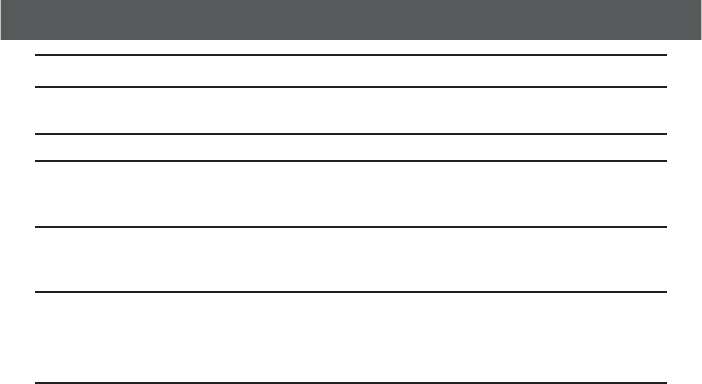
14
Industry Canada
Operation is subject to the following two conditions: (1) this device may not cause harmful
interference, and (2) this device must accept any interference, including interference that may cause
undesired operation.
The term ‘’IC:‘’ before the certification/registration number only signifies that the Industry Canada
technical specifications were met.
The Ringer Equivalence Number (REN) for this terminal equipment is 0.1. The REN is an indication of
the maximum number of devices allowed to be connected to a telephone interface. The termination on
an interface may consist of any combination of devices subject only to the requirement that the sum of
the RENs of all the devices does not exceed five.
This product meets the applicable Industry Canada technical specifications.
Frequency control Crystal controlled PLL synthesizer
Transmit frequency Handset: 1921.536-1928.448 MHz
Telephone base: 1921.536-1928.448MHz
Channels 5
Nominal effective range Maximum power allowed by FCC and IC. Actual operating
range may vary according to environmental conditions at
the time of use.
Power requirements Handset: 2.4V Ni-MH battery
Telephone base: 6V AC @ 300mA
Charger: 6V AC @ 300mA
Memory Handset directory:
30 memory locations; up to 30 digits and 15 characters
Handset caller ID log:
30 memory locations; up to 24 digits and 15 characters
VTECH TELECOMMUNICATIONS LTD.
A member of THE VTECH GROUP OF COMPANIES.
Distributed in the U.S.A. by VTech Communications, Inc., Beaverton, Oregon 97008.
Distributed in Canada by VTech Technologies Canada Ltd., Richmond, B.C. V6W 1L5.
VTech is the registered trademark of VTech Holdings Limited.
Copyright © 2012 for VTECH TELECOMMUNICATIONS LTD.
All rights reserved.
Printed in China.
91-006297-010-100
Technical specifications